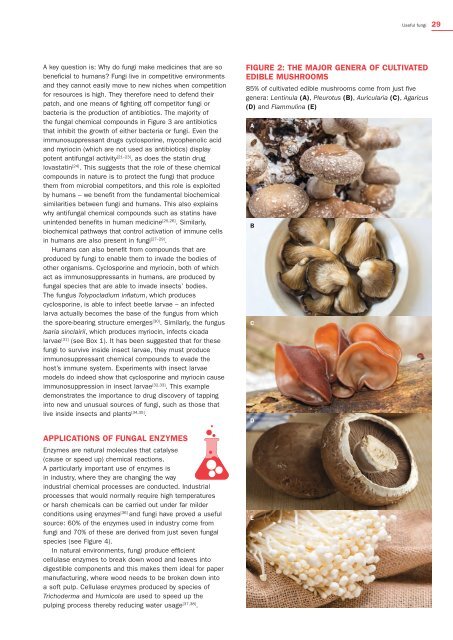gom1
You also want an ePaper? Increase the reach of your titles
YUMPU automatically turns print PDFs into web optimized ePapers that Google loves.
Useful fungi<br />
29<br />
A key question is: Why do fungi make medicines that are so<br />
beneficial to humans? Fungi live in competitive environments<br />
and they cannot easily move to new niches when competition<br />
for resources is high. They therefore need to defend their<br />
patch, and one means of fighting off competitor fungi or<br />
bacteria is the production of antibiotics. The majority of<br />
the fungal chemical compounds in Figure 3 are antibiotics<br />
that inhibit the growth of either bacteria or fungi. Even the<br />
immunosuppressant drugs cyclosporine, mycophenolic acid<br />
and myriocin (which are not used as antibiotics) display<br />
potent antifungal activity [21–23] , as does the statin drug<br />
lovastatin [24] . This suggests that the role of these chemical<br />
compounds in nature is to protect the fungi that produce<br />
them from microbial competitors, and this role is exploited<br />
by humans – we benefit from the fundamental biochemical<br />
similarities between fungi and humans. This also explains<br />
why antifungal chemical compounds such as statins have<br />
unintended benefits in human medicine [25,26] . Similarly,<br />
biochemical pathways that control activation of immune cells<br />
in humans are also present in fungi [27–29] .<br />
Humans can also benefit from compounds that are<br />
produced by fungi to enable them to invade the bodies of<br />
other organisms. Cyclosporine and myriocin, both of which<br />
act as immunosuppressants in humans, are produced by<br />
fungal species that are able to invade insects’ bodies.<br />
The fungus Tolypocladium inflatum, which produces<br />
cyclosporine, is able to infect beetle larvae – an infected<br />
larva actually becomes the base of the fungus from which<br />
the spore-bearing structure emerges [30] . Similarly, the fungus<br />
Isaria sinclairii, which produces myriocin, infects cicada<br />
larvae [31] (see Box 1). It has been suggested that for these<br />
fungi to survive inside insect larvae, they must produce<br />
immunosuppressant chemical compounds to evade the<br />
host’s immune system. Experiments with insect larvae<br />
models do indeed show that cyclosporine and myriocin cause<br />
immunosuppression in insect larvae [32,33] . This example<br />
demonstrates the importance to drug discovery of tapping<br />
into new and unusual sources of fungi, such as those that<br />
live inside insects and plants [34,35] .<br />
APPLICATIONS OF FUNGAL ENZYMES<br />
Enzymes are natural molecules that catalyse<br />
(cause or speed up) chemical reactions.<br />
A particularly important use of enzymes is<br />
in industry, where they are changing the way<br />
industrial chemical processes are conducted. Industrial<br />
processes that would normally require high temperatures<br />
or harsh chemicals can be carried out under far milder<br />
conditions using enzymes [36] and fungi have proved a useful<br />
source: 60% of the enzymes used in industry come from<br />
fungi and 70% of these are derived from just seven fungal<br />
species (see Figure 4).<br />
In natural environments, fungi produce efficient<br />
cellulase enzymes to break down wood and leaves into<br />
digestible components and this makes them ideal for paper<br />
manufacturing, where wood needs to be broken down into<br />
a soft pulp. Cellulase enzymes produced by species of<br />
Trichoderma and Humicola are used to speed up the<br />
pulping process thereby reducing water usage [37,38] .<br />
FIGURE 2: THE MAJOR GENERA OF CULTIVATED<br />
EDIBLE MUSHROOMS<br />
85% of cultivated edible mushrooms come from just five<br />
genera: Lentinula (A), Pleurotus (B), Auricularia (C), Agaricus<br />
(D) and Flammulina (E)<br />
A<br />
B<br />
C<br />
D<br />
E

















